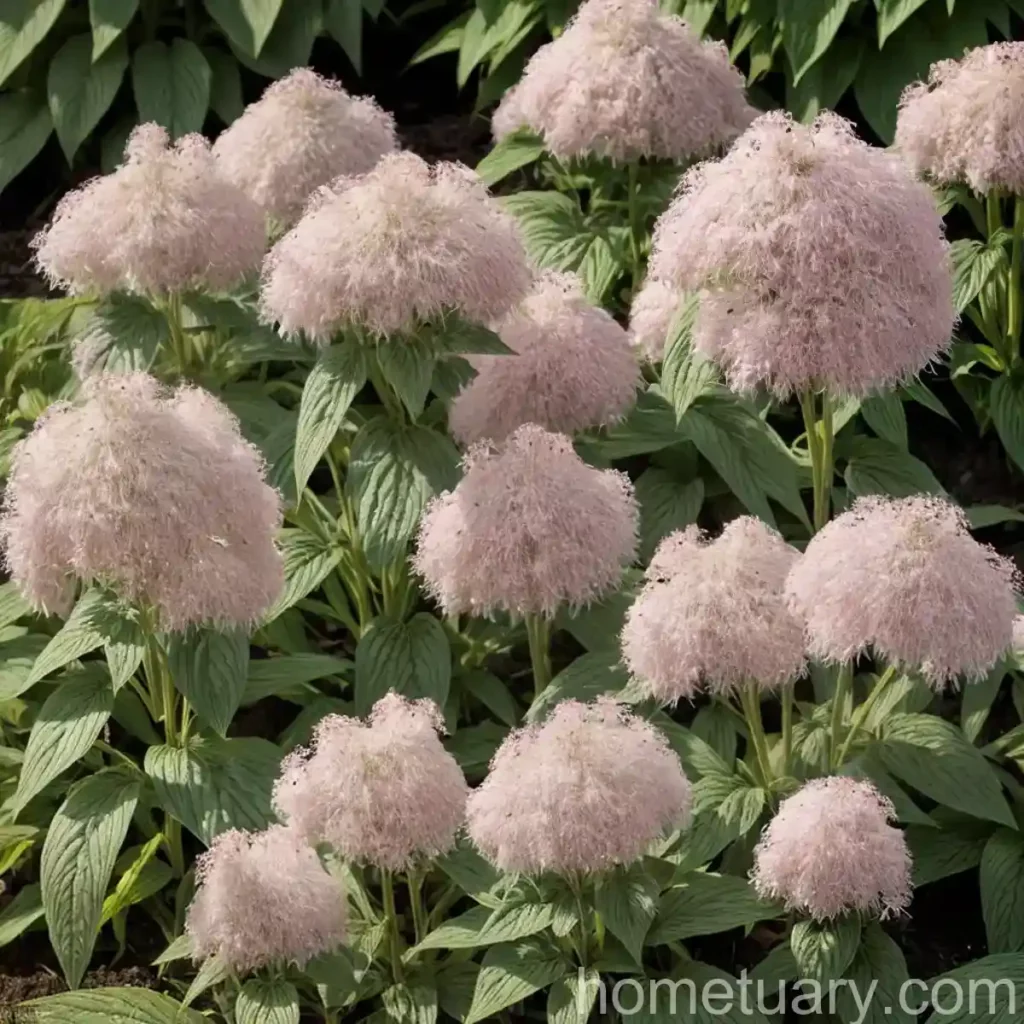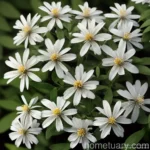Joe Pye Weed (Eutrochium dubium ‘Baby Joe’): A Comprehensive Guide
Joe Pye weed, also known as Eutrochium dubium ‘Baby Joe’, is a stunning perennial plant that is cherished for its impressive size, attractive foliage, and its ability to attract a myriad of pollinators. In this comprehensive guide, we will delve into the nitty-gritty details of this plant, covering its cultural requirements, uses, propagation, care tips, and much more. Whether you’re a seasoned gardener or a novice enthusiast, you’ll find valuable insights and practical advice to help you successfully cultivate and appreciate the beauty of Joe Pye weed.
What is Joe Pye Weed (Eutrochium dubium ‘Baby Joe’)?
Joe Pye weed, scientifically known as Eutrochium dubium ‘Baby Joe’, is a native North American perennial plant renowned for its striking, dome-shaped flower clusters and its impressive height, which can reach up to 3-4 feet. It belongs to the Asteraceae family and is closely related to bonesets and other Eutrochium species.
This plant is named after a Native American herbalist, Joe Pye, who is said to have used the plant medicinally. The ‘Baby Joe’ cultivar is a compact and more manageable variety of the species, making it an excellent addition to gardens of various sizes.
Joe Pye weed is characterized by its large, whorled leaves and clusters of tiny, mauve-pink flowers that bloom from mid to late summer, attracting a host of pollinators, including butterflies and bees. The hardiness, ease of cultivation, and ornamental appeal of Joe Pye weed make it a sought-after addition to perennial borders, naturalistic plantings, and wildlife gardens.
Now, let’s take a closer look at the key aspects of cultivating and caring for Joe Pye weed, including its cultural requirements, uses, propagation, care guidelines, and common diseases and pests.
Key Takeaways – Joe Pye Weed (Eutrochium dubium ‘Baby Joe’)
Before diving into the specifics of Joe Pye weed care and cultivation, let’s outline the key takeaways for easy reference:
- Plant Name: Joe Pye Weed (Eutrochium dubium ‘Baby Joe’)
- Botanical Family: Asteraceae
- Common Names: Joe Pye Weed, Spotted Joe Pye Weed, Eutrochium ‘Baby Joe’
- Plant Type: Herbaceous perennial
- Mature Height: 3-4 feet
- Flower Color: Mauve-pink
- Blooming Period: Mid to late summer
- Water Requirements: Medium to high
- Sunlight: Full sun to partial shade
- Soil Type: Moist, well-draining soil
- Native Habitat: North America
- Main Uses: Ornamental, pollinator attractant, wildlife habitat
- Hardiness Zones: 4-9
Culture
Water
Joe Pye weed thrives in moderately moist to wet soil. While it can tolerate periods of drought, consistent moisture is essential for optimal growth and flowering. During prolonged dry spells, regular watering is necessary to maintain the soil’s moisture levels, particularly for newly planted specimens and those grown in containers.
Sunlight
In terms of sunlight requirements, Joe Pye weed is quite versatile and can adapt to varying light conditions. It performs best in full sun to partial shade, although it may benefit from some relief from the intense afternoon sun in hotter climates. When grown in shadier locations, the plant may produce slightly fewer flower clusters, but it will still remain vigorous and attractive.
Fertilizer
Being a relatively low-maintenance plant, Joe Pye weed generally does not require heavy fertilization. Incorporating a balanced, slow-release fertilizer into the soil during the spring, just as new growth emerges, can provide the plant with the necessary nutrients for healthy development and robust flowering. A layer of organic mulch applied around the base of the plant can help conserve soil moisture and provide a gentle nutrient boost as it decomposes.
Soil
For optimal growth and performance, Joe Pye weed should be planted in rich, moist, and well-draining soil. It has a preference for slightly acidic to neutral soil pH levels and can thrive in loamy or clayey soils. Prior to planting, amending the soil with organic matter, such as compost or well-rotted manure, can improve its structure and fertility, ensuring an ideal growing environment for the plant.
Pruning
Pruning Joe Pye weed is generally straightforward and entails the removal of spent flower heads to prolong the blooming period and prevent the plant from self-seeding. In late fall or early spring, cutting back the withered stems to ground level can help rejuvenate the plant and promote robust growth in the upcoming season. Additionally, the removal of any damaged or diseased foliage can enhance the plant’s overall vigor and appearance.
Uses
The versatile nature of Joe Pye weed makes it suitable for a range of landscape and gardening purposes, including:
-
Ornamental Use: As an ornamental perennial, Joe Pye weed adds vertical interest and visual appeal to mixed borders, cottage gardens, and naturalistic plantings. Its large, showy flower clusters and attractive foliage make it a standout feature in the landscape, especially when planted in groups or drifts.
-
Pollinator Attraction: With its nectar-rich flowers and prolific blooming, Joe Pye weed is a favorite among pollinators, including butterflies, bees, and hummingbirds. By incorporating this plant into gardens and natural habitats, it can play a crucial role in supporting pollinator populations and promoting biodiversity.
-
Wildlife Habitat: The dense foliage and sturdy stems of Joe Pye weed provide valuable shelter and nesting sites for various wildlife, making it an important addition to wildlife gardens, wetland restorations, and naturalized landscapes. In addition to attracting pollinators, Joe Pye weed can also host a multitude of beneficial insects and contribute to the overall ecological balance of the garden.
Propagation
Division
Propagating Joe Pye weed through division is a simple and effective method to increase your plant stock and rejuvenate established clumps. This process is typically carried out in early spring as new growth begins to emerge, or in fall as the plant enters dormancy. Here’s a basic guide to dividing Joe Pye weed:
-
Prepare the Plant: Before dividing, water the plant thoroughly to hydrate the root system and make it easier to lift from the ground.
-
Digging and Dividing: Carefully dig around the outer perimeter of the plant, ensuring you unearth as much of the root system as possible. Once the plant is lifted, use a sharp garden spade or knife to divide the root mass into smaller sections, each containing several vigorous shoots and a healthy root network.
-
Replanting: Select suitable planting locations for the divided segments and ensure they are positioned at the same depth as the original plant. Water the newly transplanted divisions generously to help them establish and adapt to their new surroundings.
Seed Propagation
While Joe Pye weed can be grown from seed, this method requires patience and may take longer to produce mature, flowering plants. Sowing the seeds in a prepared seedbed or individual containers in the fall can facilitate natural cold stratification, promoting germination in the following spring. Once seedlings have developed and gained some size, they can be transplanted into their permanent positions in the garden or larger containers.
Container Popularity
The compact and manageable nature of the ‘Baby Joe’ cultivar makes it an excellent candidate for container gardening, allowing plant enthusiasts with limited garden space to enjoy the beauty of Joe Pye weed on patios, balconies, and terraces. When grown in containers, this plant can benefit from consistent moisture and may require more frequent watering, especially during hot, dry periods. Additionally, providing a rich, well-draining potting mix and a sunny or partially shaded location can help ensure the plant’s health and vigor in a containerized environment.
Common Diseases
Disease Diagnosis
Despite its overall resilience, Joe Pye weed can be susceptible to certain diseases and issues. Identifying and addressing these concerns in a timely manner is essential for maintaining the plant’s health and vitality. Some common diseases and disorders that may affect Joe Pye weed include:
-
Powdery Mildew: A fungal disease that presents as a powdery, white coating on the leaves, stems, and flowers, particularly during warm, humid weather. Proper air circulation, adequate spacing between plants, and the removal of affected plant material can help prevent and manage powdery mildew.
-
Root Rot: Excessive moisture, poor drainage, or soil compaction can lead to root rot in Joe Pye weed, causing the plant to exhibit wilting, yellowing foliage, and overall decline. Improving soil drainage, avoiding overwatering, and providing proper soil structure can mitigate the risk of root rot.
-
Leaf Spot: Leaf spot diseases, characterized by the presence of dark, concentric lesions on the foliage, can occur under conditions of high humidity and prolonged leaf wetness. Pruning affected foliage, promoting good air circulation, and avoiding overhead watering can aid in preventing leaf spot diseases.
Common Pests
While Joe Pye weed is relatively resistant to pest infestations, it may occasionally encounter certain insect visitors that can cause damage to the plant. Some common pests that may affect Joe Pye weed include:
-
Aphids: Small, sap-sucking insects that may gather on the tender, new growth of Joe Pye weed, causing distortion and discoloration of the leaves. Insecticidal soaps, neem oil, or a strong stream of water can help control aphid populations without harming beneficial insects.
-
Japanese Beetles: These voracious pests can feed on the foliage and flowers of Joe Pye weed, causing skeletonization of the leaves and diminishing the plant’s ornamental appeal. Handpicking, traps, and biological controls can aid in managing Japanese beetle populations in the garden.
Botanist’s Tips
To ensure the successful cultivation and enjoyment of Joe Pye weed in your garden, consider the following expert tips and recommendations:
-
Pollinator Management: When integrating Joe Pye weed into your landscape, consider companion plantings that support and attract a diverse array of pollinators, including other nectar-rich perennials, annuals, and flowering shrubs. This can create a balanced and inviting habitat for beneficial insects and wildlife.
-
Soil Preparation: Investing time and effort into preparing the soil for Joe Pye weed by amending it with organic matter, such as compost or well-rotted manure, can lay the foundation for healthy, vigorous growth and robust flowering.
-
Seasonal Care: Pay attention to the plant’s needs during different seasons, adjusting watering, fertilization, and maintenance practices according to the plant’s growth cycle and environmental conditions. This can ensure the plant’s long-term health and resilience.
Fun Facts
- Joe Pye weed was historically used by Native American tribes and early settlers for medicinal purposes, with its leaves and flowers reportedly employed to treat a variety of ailments.
- The plant’s common name, “Joe Pye weed”, is an homage to a historical figure, Joe Pye, who was recognized for his knowledge of herbal medicine and is said to have utilized this plant for health-related purposes.
- In addition to its ornamental and ecological value, Joe Pye weed’s large, architectural form and distinctive flowering clusters make it a captivating focal point in the garden, especially when planted in groupings or as a backdrop to smaller perennials and annuals.
Links to External Resources
For further information on Joe Pye weed (Eutrochium dubium ‘Baby Joe’), its cultivation, uses, and ecological significance, consider exploring the following reputable resources and references:
- The United States Department of Agriculture (USDA) Plant Database
- The North American Native Plant Society
- The National Gardening Association
- The American Horticultural Society
- The Lady Bird Johnson Wildflower Center
In conclusion, Joe Pye weed (Eutrochium dubium ‘Baby Joe’) stands out as a versatile, attractive, and ecologically valuable plant that holds immense appeal for gardeners and nature enthusiasts alike. With its impressive stature, captivating flowers, and unrivaled ability to draw in beneficial wildlife, this native perennial makes a welcome addition to a wide range of garden settings, from rain gardens and pollinator meadows to informal borders and containers. By understanding and implementing the cultural guidelines, uses, and propagation techniques discussed in this guide, you can confidently cultivate and savor the extraordinary beauty of Joe Pye weed in your own backyard, while also contributing to the preservation of native plant species and the promotion of biodiversity in your local ecosystem.















